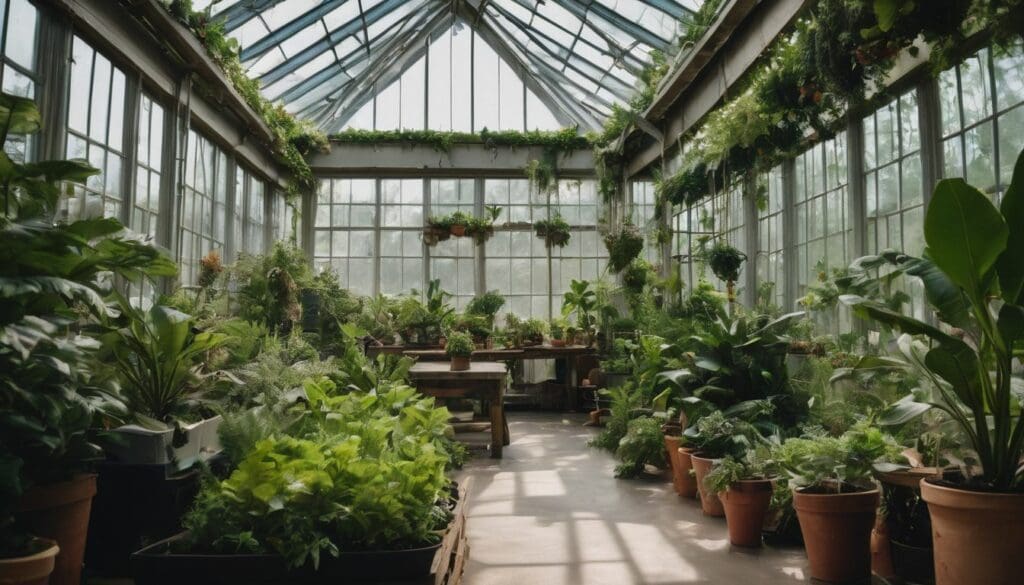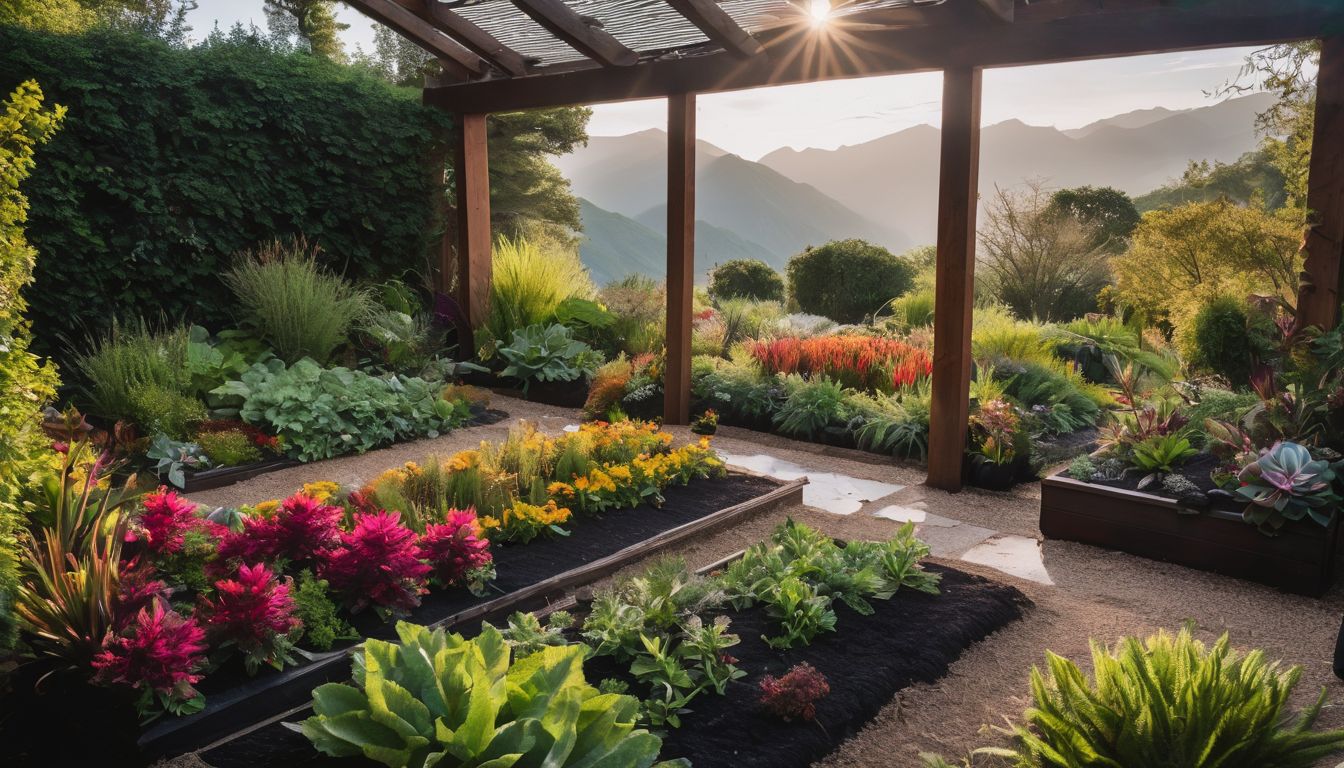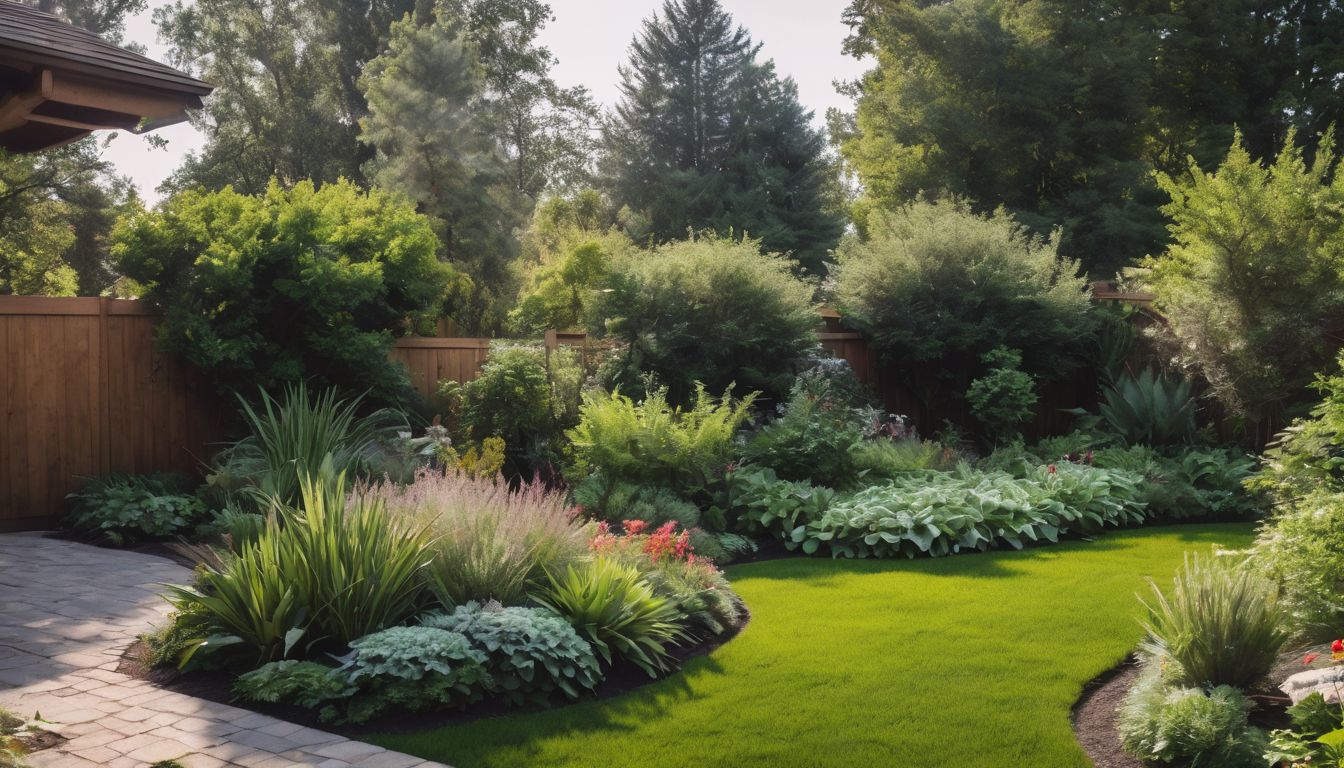Fighting the unpredictable British weather can be a gardener’s biggest challenge. A greenhouse provides an all-year-round growing climate for plants, regardless of rain or shine. Our guide offers practical steps to create your own plant haven, ensuring your gardening efforts bear fruit every season.
Let’s dig in and grow together!
Key Takeaways
- Greenhouses provide a controlled environment for plant growth in the UK, offering protection from unpredictable weather while extending the growing season.
- When setting up a greenhouse, it’s crucial to choose a location with ample sunlight and good drainage, select durable materials suited for UK weather, and employ effective ventilation systems.
- Various types of greenhouses cater to different needs—from lean – to structures for space conservation to large polytunnels for extensive planting—making it important to assess your requirements before building.
- Essential greenhouse tools include thermometers, hygrometers, watering systems, shading materials, potting benches, and efficient shelving or staging to maximise space usage.
- Successful greenhouse gardening involves regular maintenance like cleaning and temperature control as well as careful planning such as avoiding overcrowding plants and using quality soil.
The Importance of a Greenhouse for Gardening in the UK
A greenhouse is essential for gardening in the UK as it provides a controlled environment for plants to thrive, protecting them from harsh weather conditions. Choosing the right greenhouse and location is crucial for successful horticulture.
Benefits of a Greenhouse
Greenhouses offer a controlled environment, crucial for UK gardening where unpredictable weather can harm plants. They extend the growing season, allowing gardeners to cultivate fruits and vegetables all year round.
Greenhouses protect crops from excessive rain, frost, and pests that thrive in outdoor conditions. This secure setting also means less need for chemical pesticides, supporting a more organic approach to horticulture.
Cultivating plants inside a greenhouse conserves water by reducing evaporation compared to open-air gardens. It creates an ideal climate for growth even during off-peak seasons, making it possible for you to enjoy fresh produce any time.
Plus, with the ability to propagate seeds earlier in the spring and keep producing into the colder months, greenhouses enhance food security and personal self-sufficiency.
How to Choose the Right Greenhouse
Consider the space you have available. Look for a greenhouse that fits your garden layout and size restrictions while allowing room for growth. Assess how much light is available in the chosen area as it will affect what plants can grow successfully inside.
Select a design that complements your home and garden aesthetic, such as a Victorian-style greenhouse or a modern glass structure.
Choose a material suitable for the UK climate to ensure durability, like aluminium or cedar wood. Factor in ventilation options such as windows and vents, crucial to maintaining optimal growing conditions.
Choosing the Perfect Spot
Select a spot for your greenhouse that receives ample sunlight, ideally facing south or southwest to capture the most daylight. Ensure the area is level and provides good drainage to prevent water accumulation around the structure.
Consider proximity to utilities like water and electricity for convenience. Keep in mind any potential obstructions such as trees or buildings that may block sunlight or pose hazards during severe weather conditions.
Inspect the location throughout the day to assess its sun exposure and shade patterns, especially during different seasons. Avoid areas prone to strong winds which can damage your greenhouse and harm plants inside.
Building Your Greenhouse
Choosing the right type of greenhouse and knowing how to construct it is essential in creating a successful gardening space. From understanding different types of greenhouses to learning construction tips and gathering essential kit and accessories, this section will guide you through the process.
Types of Greenhouses
Greenhouses come in various types and sizes to suit different gardening needs.
- Lean-to Greenhouses: These are attached to an existing structure, making them space-efficient and easy to access for maintenance.
- Free-Standing Greenhouses: These stand alone and offer more flexibility in terms of size and location within the garden.
- Mini-Greenhouses: Compact and portable, perfect for small gardens or balconies.
- Polycarbonate Greenhouses: Ideal for larger-scale production, providing ample space for extensive planting.
- Victorian Greenhouses: Traditional and elegant structures with ornate designs, adding a touch of charm to any garden setting.
- Hoop Houses: Affordable and easy to assemble, providing a cost-effective solution for seasonal growing needs.
- Glass vs Polycarbonate: Choose between traditional glass panels or modern polycarbonate sheets based on desired durability, insulation, and budget requirements.
Construction Tips
After choosing the perfect spot and deciding on the type of greenhouse that suits your needs, it’s time to focus on constructing your greenhouse. Here are some essential construction tips:
- Prepare the site by ensuring it is level and well – drained to provide a stable foundation for the greenhouse.
- Follow the manufacturer’s instructions carefully during assembly to ensure a secure structure.
- Use durable materials and invest in high-quality components to withstand the UK climate.
- Consider adding additional insulation to improve temperature regulation within your greenhouse.
- Install efficient ventilation systems to maintain optimal airflow and prevent humidity build-up.
- Secure the greenhouse firmly to the ground or a foundation to withstand strong winds and storms.
Essential Kit and Accessories
When setting up your greenhouse, certain essential tools and accessories will help you maintain an optimal gardening environment. Here are the key items you’ll need:
- Thermometer and Hygrometer: Monitoring the temperature and humidity levels is vital for plant health.
- Watering Cans or Hose: Ensuring your plants receive adequate water is crucial; choose a watering method that best fits your setup.
- Shading Materials: Use shade cloths or blinds to protect plants from excessive sunlight during hot days.
- Potting Bench: A dedicated space for potting and re-potting plants will make gardening tasks more manageable.
- Pots, Trays, and Grow Bags: Different containers are essential for seedlings, cuttings, and mature plants.
- Seed Trays and Propagators: Essential for starting seeds in a controlled environment.
- Pruning Shears and Hand Tools: Keeping your tools sharp and handy makes maintaining your greenhouse a breeze.
- Benches or Shelving Units: Create efficient use of vertical space by utilising shelving units to keep plants organised.
Maintaining Your Greenhouse
Keeping your greenhouse clean and well-ventilated is essential for healthy plant growth, along with proper heating and maximising space efficiency. Find out more about maintaining your greenhouse for optimal gardening in the UK.
Cleaning and Ventilation
To maintain a healthy growing environment for your plants, regular cleaning and ventilation are essential. Here’s how to keep your greenhouse clean and properly ventilated:
- Regularly sweep the floor and remove any debris or dead plant matter.
- Wipe down all surfaces with a mild soap solution to remove dust, dirt, and potential pathogens.
- Clean the windows inside and out to allow maximum light penetration.
- Check for any blockages in the vents and ensure they are fully operational.
- Install an automatic vent opener to regulate temperature and airflow if needed.
- Consider using natural ventilation methods such as louvre windows or roof vents for effective air circulation without power consumption.
Heating Your Greenhouse
After ensuring proper cleaning and ventilation, maintaining an ideal temperature inside your greenhouse is crucial for the health of your plants. Installing a reliable heating system is essential, especially during the colder months in the UK.
Utilising a combination of electric heaters, gas heaters, or even geothermal heating can help create an optimal environment for your plants to thrive. It’s important to monitor the temperature regularly and adjust the heating system as needed to ensure a consistent and suitable climate for your crops throughout the year.
To further enhance energy efficiency, consider insulating your greenhouse with thermal screens or bubble wrap to retain heat. Additionally, utilising renewable energy sources such as solar panels can significantly reduce environmental impact while providing sustainable heating for your greenhouse.
Utilising Space Efficiently
To make the most of your greenhouse space, consider these tips:
- Install shelving and hanging baskets to create vertical growing space for smaller plants and herbs.
- Use staging or benches to separate different levels of plant growth, making the most of available sunlight.
- Implement a trellis system for climbing plants like cucumbers and tomatoes to maximise ground space.
- Utilise seed trays and propagators to start seedlings or propagate new plants in a compact and organised manner.
- Incorporate movable containers or pots to easily rearrange the layout as needed without wasting valuable space.
Growing Vegetables in Your Greenhouse
– Discover the best vegetables for beginners to grow in your UK greenhouse and learn planting and propagating tips to ensure a successful harvest. Also, uncover common mistakes to avoid when growing vegetables in a greenhouse.
Best Vegetables for Beginners
To get started with vegetable gardening in your greenhouse, consider these excellent options:
- Tomatoes – Ideal for beginners, they thrive in the warm and controlled environment of a greenhouse, producing a bountiful harvest.
- Lettuce – Easy to grow and perfect for salads, lettuce can be continually harvested for a fresh supply throughout the growing season.
- Cucumbers – With proper support and regular watering, cucumbers flourish in the warmth of a greenhouse, providing an abundant crop.
- Radishes – Fast-growing and low-maintenance, radishes are perfect for beginners looking for quick results.
- Peppers – Both sweet and hot peppers thrive in the protected environment of a greenhouse, offering a rewarding yield.
Planting and Propagating Tips
After choosing the best vegetables for beginners, it’s essential to understand the planting and propagating tips to ensure your greenhouse gardening in the UK is successful. Here are some tips to help you get started:
- Prepare the soil by loosening it with a spade or fork and adding organic matter such as compost to improve its structure and fertility.
- Sow seeds at the recommended depth and space them according to the instructions on the seed packet.
- Water the seeds gently but thoroughly, ensuring that the soil remains moist but not waterlogged.
- Provide adequate support for plants that need it, such as staking tomatoes or using trellises for climbing plants like cucumbers and peas.
- Monitor plant growth regularly and take necessary steps to protect against pests and diseases, such as using organic pest control methods or creating barriers like netting.
- For propagating new plants from cuttings, use a sharp, clean knife or shears to take healthy stem cuttings from mature plants, then plant them in a suitable growing medium with good drainage.
- Ensure proper humidity levels for propagation by covering the cuttings with a plastic bag or placing them in a propagator until they have developed roots.
- Once roots have formed, gradually acclimatise new plants to their growing environment before transplanting them into larger containers or directly into the greenhouse soil.
Common Mistakes to Avoid
- Overcrowding: Avoid planting too many crops in a limited space, which can lead to competition for light, water, and nutrients.
- Neglecting ventilation: Failure to provide adequate airflow can result in the build-up of humidity and the spread of diseases among plants.
- Ignoring temperature control: Failure to regulate temperatures can lead to stress on plants, affecting their growth and productivity.
- Using poor-quality soil: Using subpar soil can limit the growth potential of your crops and make them more susceptible to disease.
- Skipping regular maintenance: Neglecting routine maintenance tasks such as cleaning and pest control can lead to long-term issues in your greenhouse.
Conclusion
In conclusion, greenhouse gardening in the UK offers numerous benefits for environmentally conscious individuals. With the right tools and knowledge, anyone can build and maintain a successful greenhouse garden.
By implementing proper techniques and choosing suitable plants, you can contribute positively to conservation efforts while enjoying fresh produce all year round. Taking these steps will result in a thriving greenhouse garden that supports both your passion for gardening and environmental sustainability.
FAQs
1. What is greenhouse gardening in the UK?
Greenhouse gardening in the UK is a method of growing plants, like flowers and vegetables, inside a structure that protects them from extreme weather.
2. Can I grow plants all year round with greenhouse gardening?
Yes, you can grow plants throughout the entire year using a greenhouse even during the cold months because it keeps your agriculture warm and guarded against frost.
3. What are some benefits of using a greenhouse for my garden?
A greenhouse offers many advantages such as allowing you to cultivate a wider variety of flowers and keep pests out while providing an ideal climate for your plants.
4. Do I need special skills to start greenhouse gardening in the UK?
No specific skills are needed to begin; however, learning some basic knowledge about plant care and how to maintain proper temperature will help ensure your success in greenhouse gardening.





